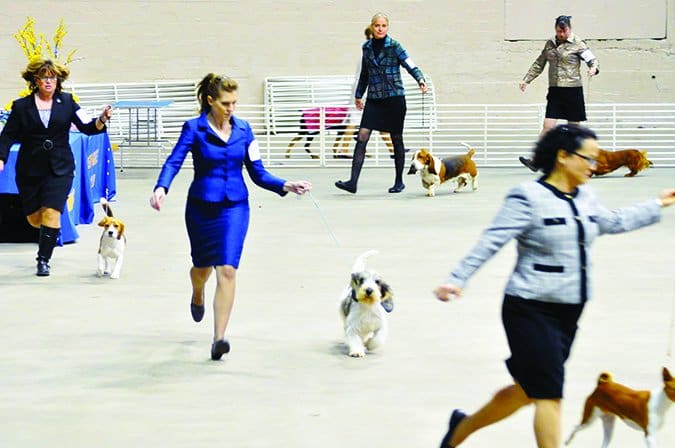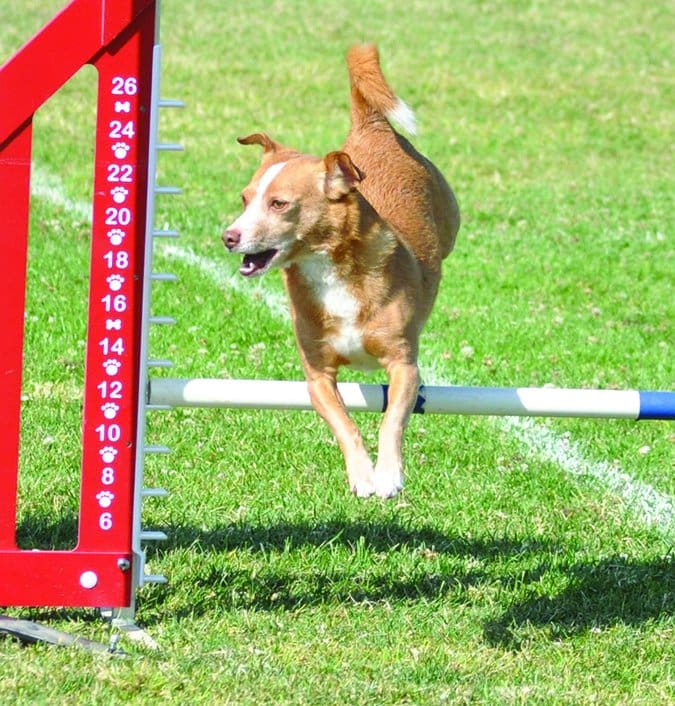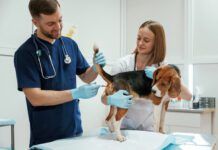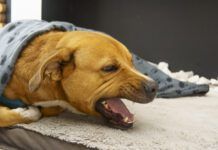If you’re not part of the dog-show world, you might think of dog shows as ridiculous beauty contests for four-leggers, only with rosetted ribbons in place of rhinestone tiaras. Admittedly, some coated breeds do use their fair share of hair spray – and even hair extensions if you’re in the Poodle ring! And, because judges have different priorities – not to mention different levels of competence – there may be some who make their decisions based purely on cosmetic considerations like flash and showmanship. But the real point of shows is a dog’s “conformation” – how he’s built, and how that structure affects the way he moves and what he can do.
“He has such a beautiful prance,” puppy owners will tell me, describing what they see when their dog is moving freely around their property, motoring over to check if that squirrel has dared to reinsert himself among the azaleas. In fact, the dog is likely displaying the gait I’ve worked hard to maintain in his breed – a smooth, efficient, ground-covering trot that Ridgebacks can ideally use all day long, whether keeping track of the family cat in the backyard or tracking a lion across the savannah in their native Zimbabwe. But I think that novice owners use (or, as the case may be, misuse) the word “prance” to describe movement that even to their untrained eye seems smooth, functional, and sound, even if they don’t quite know the correct jargon for it.

No matter what the breed, the sheer soundness of a dog – the strength and balance of her overall anatomy, and how that translates kinetically in the dog’s ability to move from Point A to Point B – is a huge consideration, whether the dog is trotting around a show ring or jogging around your town accompanying you in your quest for 12,000 steps. Soundness is not just an abstract concept for breeders like me; it’s an absolute goal! We want nothing more than to produce dogs who can be active throughout a lifetime without injury – and look great (and feel good) doing it.
Even the best and most responsible breeders can’t absolutely predict the physical result of every genetic combination, though I assure you we try. Sadly, not all pedigreed dogs are bred with much thought at all, and many, many dogs are the result of human neglect and mismanagement. Whether your dog is the result of a breeding that took decades of planning and anticipation, or a few moments of careless inattention, you should be aware of his degree of soundness before you plan for his canine sport career (or ask him to keep you company as you condition for your own).
If you are aware of your dog’s conformation faults – his points of physical vulnerability – you can take steps to build his condition to improve or preserve as much physical strength and ability as possible. Keep in mind that preservation of his fitness is not just about winning titles in rigorous dog sports, or being able to conduct all-day searches for missing humans; in your dog’s case, it may entail simply being able to jump onto your bed or sofa well into his senior years, or enjoying slow but pain-free walks around the block until the day he dies. A dog’s soundness should be a goal for every good dog owner.
Study Your Dog’s Physique
For all our desire to understand dogs and how best to care for them, we as a dog culture are woefully undereducated about the basics of canine anatomy and construction, and how they translate to our dogs’ well being. Most of us know the very basics, for example, if you have a brachycephalic dog (one with a short head, or flattened face, like Pugs, Boston Terriers, or Pekingese), you should know not to let him overheat in hot weather. If you have a hairless dog, you will surely apply sunscreen before going out on a summer outing, or put on his coat if it’s the dead of winter.
But many owners are completely ignorant about their dogs’ more subtle structural weaknesses, so they can’t possibly factor the vulnerabilities into their dogs’ activities – they don’t know that the deficiencies exist in the first place. And dogs often don’t give us clear signals that something is uncomfortable or painful.
A disclaimer before we begin: Every breed is different, because different purposes require different structures. While all dogs should have a basic soundness that ensures their quality of life, their construction varies depending on breed and purpose.
For example, toy breeds that were created primarily for companionship can’t match the stamina of Retrievers. Similarly, Greyhounds, which are sprinters, aren’t going to have the same structure as endurance trotters like Dalmatians. But even if you have a dog who was bred randomly rather than purposefully, all these same assessments apply; a sound dog is a sound dog, whether or not she has a pedigree. A dog shouldn’t have to limp to give you evidence that he’s not built to go the distance; if your eye has been trained to look for it, little hiccups in movement and structure can signal the potential for weakness and injuries to come, and prompt an alert owner to take steps to prevent problems.
Theresa M. Lyons

The Gait Analysis
The way a dog is constructed reveals itself in how the dog moves, which is why dogs in the conformation show ring are evaluated both standing and moving. They are judged at the trot, despite the fact that some breeds are not natural-born trotters, because the trot is a useful and energy-saving gait. All the exertion in a trot is divided equally over all four limbs, and it’s an ideal gait for traversing long distances, even if the terrain is uneven. Wild animals naturally trot when they are looking for food, and all domestic quadrupeds use the gait as well. (In old African safari books, I’ve even come across photos of a rhinoceros trotting as smartly as a terrier!)
The trot is a rhythmic two-beat diagonal gait, which means that the front left leg and the right rear leg move as a pair, and the front right leg and the left hind leg move together. One diagonal pair moves forward in unison while the other pair swing backward, supporting the dog’s weight. As each front foot reaches its most backward swing, the rear foot on the same side should be at its most forward, dropping onto the ground in the next split second to carry the dog forward. Meanwhile, on the other side of the dog, the front and rear legs are in the opposite position, fully extended.
With most breeds, what you want is a smooth, effortless trot – nothing jarring, no interference between the feet or legs as the dog gains speed. That said, some breeds roll as they trot – in other words, you see a bit of side-to-side movement. You’ll observe that in Bulldogs, for example, as well as in breeds with who carry a great deal of weight and substance, such as Neapolitan Mastiffs. Neither of those breeds were bred to be endurance trotters, though, and if you own one we hope you don’t plan on taking him on 5k (or longer) runs.
Watching from the side as a dog trots can give you a wealth of information about how that dog is structured. If the dog takes short, mincing front steps, or has to lower her head in order to extend her front leg to prevent it from colliding with the rear one, you should take a closer look at her front structure. Similarly, if she reaches by extending her front leg out from the elbow instead of the shoulder – if you see a pronounced “crack” at the elbow, instead of one relatively unbroken line from the shoulder to the toe – she is also likely not built correctly in the front end. If she is out of balance – if she is too short-bodied, or her rear is too angled for her front – then she might crab or sidewind, literally torqueing her body sideways so her rear feet don’t strike her front ones when she moves.
Dog breeders and handlers have evolved a number of evocative names to describe movement faults – pounding, paddling, and goose-stepping, to name a few. But the take-home message is that any imbalance or shortcoming in a dog’s structure can contribute to the dog breaking down over time.
A Full Movement Assessment

In addition to circling around the ring at a trot, every dog at a dog show is asked to move away from the judge and then back again in a straight line. This “up and back” afford the judge a different view of the dog’s anatomy and how it works on the move. As the dog trots away, the judge can gauge the strength of the rear assembly, and on the return trip, she can assess factors like elbow placement and whether there are any deviations from normal front movement, like toeing out (where the forefeet point outward) or paddling (in which the pasterns and feet perform an exaggerated, flipping-outward, circular movement).
As in the side view, the key is to look for smooth, effortless, balanced movement. In many breeds, especially those that are bred to work in the field, the dog’s legs will naturally begin to converge on a center line as the dog gains speed and trots away. This is called single-tracking: If your dog was trotting away from you in the snow, all you would see would be one single file of tracks. (Veterinarian and structure maven Chris Zink simulates this at her seminars, dipping a demonstration dog’s feet in chalk and having him gait over the floor.)
A dog’s rear quarters are his propulsion mechanism. When a dog jumps, he naturally pushes off from his rear. So weaknesses here can have orthopedic consequences if you stretch his abilities too far.
Consider, for example, the rear pasterns (sometimes referred to as the hocks). This is the ankle area of the dog, extending from the foot up to that little round knob on the back of the joint. If the rear pasterns are so high or weak that they compromise stability, a judge can see that as the dog moves away; depending on where the weakness is, the rear pasterns might rub together, or move wide, or even wobble.
Earlier this year, one of my puppy people brought their yearling dog to me to evaluate. Periodically, while playing hard at the dog run, Simba would come up lame. Concerned, his owners took him to the vet to have his hips checked, but all was fine there.
I suspect this was the problem: Simba had hocks that were somewhat high, and his croup (the area from the point of hip to where the tail attaches) was steeper than the ideal, making it difficult to get his legs out from under him. Together, these conformation faults contributed to instability in his rear, which made it easier for him to injure himself roughhousing.
While we couldn’t change Simba’s conformation, we could strengthen it. I suggested hillwork: Walking up and down inclines, eventually graduating to figure eights, can help build muscles to compensate for weakness elsewhere. I also suggested core-strengthening exercises on canine-conditioning equipment like a peanut-shaped stability ball.
Lax hips weren’t Simba’s problem, but even dogs with this fault can be helped. I have a friend with a Newfoundland with less-than-ideal hips who used daily core training to help improve his stability. Building up his rear-leg muscles helped stabilize his pelvic area and made him much steadier on his feet.
The Scoop on Your Dog’s Shoulders
The holy grail in many breeds, especially those bred for endurance – trotting, retrieving, or generally working all day – is a “good front.” The front assembly of a dog involves a number of interrelated factors, including the length and angle of the upper arm; the depth and prominence of the prosternum, or forechest, and the length and arch of the neck. And central to the soundness of a front is the placement of the shoulder blade, or scapula.
The front end of the dog experiences the most wear and tear – 60 percent of the dog’s weight is carried on the front legs. When a dog jumps, he lands on his front feet, but it’s the scapula that acts as a shock absorber, helping dissipate the concussion from that energy transmission.
The general rule is, the more sloped the scapula is, the more effective it will be at the job of shock absorption. Conversely, the straighter or more upright the shoulder, the less effective it will be, and the increased pounding will wear and tear on the dog’s structure, setting the stage for orthopedic problems down the road.
The great irony of breeders who select for good fronts in their breeding stock is that the dogs with poorer fronts are often sold as pets, whose owners may use them as performance dogs.
There is nothing you can do to change the scapula angle that your dog has – that’s genetically determined. But what you can do is avoid excessive wear and tear on your dog’s front whenever possible.
For example, if you have a straight-fronted dog that you want to work in agility, then think about jumps the way a dieter does calories: You want to save them up for when they really count, like at an official trial. When training, minimize the number of jumping efforts. Agility training involves building skills, not jump height, so practice at a lower height to help minimize wear and tear.
Be aware of how much concussion you place on that front end over time. It might hone your awareness to keep some sort of record of how many jumps you ask your dog to take in a day, even if you do this for only a week or two.
Dragonika | Dreamstime.com

The Whole Dog
Virtually every part of a dog has functional implications. Consider, for example, feet. Many of us never do. But a dog with flat, thin, splayed feet won’t be able to travel comfortably on them for long, especially over uneven or rough ground.
Torn cruciate ligaments – the most common problem treated by veterinary orthopedists, and one that has been steadily increasing in the last several decades – also appears to have a connection to canine conformation. Breeders have long suspected that the width of the stifle (also called the knee) correlates to a predisposition to torn cruciate ligaments.
A 2009 study pointed to tibial tuberosity – the protrusion on the front of the tibia to which tendons attach, suggesting that the narrower the tibial tuberosity, the greater risk of ligament rupture. Newer studies with a focus on Labrador Retrievers are focusing on hind-limb conformation and gait, and how they impact Cranial Cruciate Ligament (CCL) disease.
Even some aspects of the dog’s conformation that seem sheerly cosmetic can have effects on his health. Eyelids that are too droopy can lead to chronic redness and irritation of the conjunctiva and eye infections. Individuals of breeds that have folding, rolling skin (like Shar Pei, Bulldogs, Pugs, and more) can have excessive skin folds that can trap moisture and bacteria, and set the stage for persistent skin infections – not to mention body odor. Dogs with crowded or crooked teeth may have trouble chewing, and their teeth may develop plaque and tartar faster than dogs with a proper bite and enough room for all their teeth.
You may not have considered the ramifications of some of your dog’s features on his long-term health, but your veterinarian might have useful insights to share. It’s worthwhile to ask whether she sees anything in your dog’s conformation that may predispose him to any particular health problems, and what you can do to prevent these.
Educating Yourself
The study of canine conformation is a lifetime endeavor, and not something you can master in one magazine article. But, luckily, there are plenty of resources for you to kick off a lifetime of learning. For example, veterinarian and performance enthusiast Dr. Christine Zink offers seminars that explain canine conformation and how it translates kinetically. Visit Canine Sports Productions for a list of her upcoming seminars. Also on the must-read list is Pat Hasting’s book, Structure in Action: The Makings of a Durable Dog.
Perhaps the best way to learn about canine conformation and how it impacts structure is to seek out a mentor who can literally show you what it’s all about. Many breeders and performance enthusiasts with an understanding of structure are often surprisingly happy to share their knowledge, as the adjustments you make to your dog’s fitness-building and -maintenance routines can only help him live a happier, healthier, more comfortable life.
Denise Flaim raises 12-year-old triplets and Rhodesian Ridgebacks on Long Island, NY.





